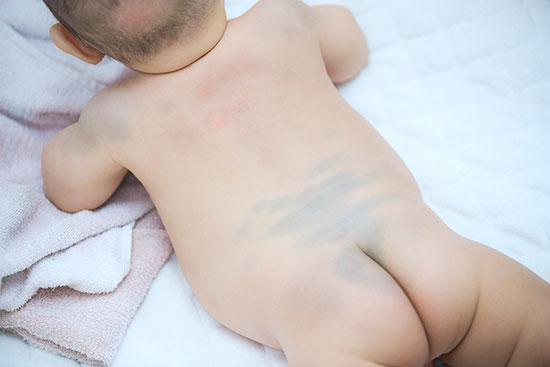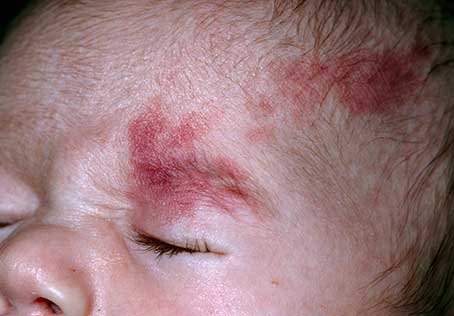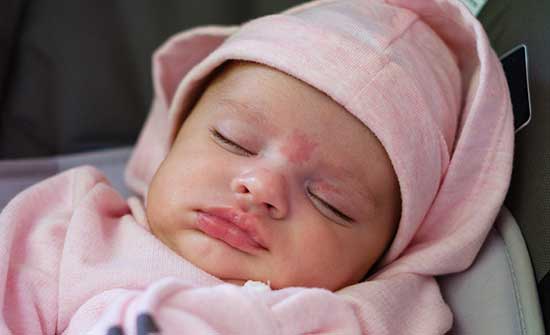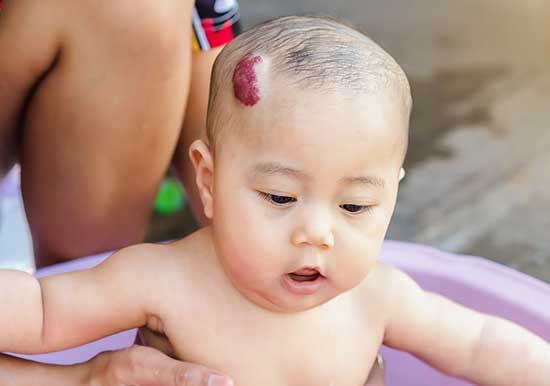Congenital dermal melanocytosis
These common birthmarks are blue-grey, flat spots, which typically appear on a baby’s lower back or buttocks. They’re usually a few centimetres in size.
Congenital dermal melanocytosis are present at birth or appear soon after. They usually disappear by 5 years of age.
Congenital dermal melanocytosis are harmless and don’t need treatment.
These birthmarks are caused by a build-up of pigment cells in the deeper part of the skin. Dark-skinned people are more likely to have them than light-skinned people.
Congenital dermal melanocytosis are also called slate grey naevi, congenital blue-grey spots and lumbosacral dermal melanocytosis. They used to be called Mongolian blue spots.

Café-au-lait macules
These common birthmarks are light-brown, flat spots, which can appear anywhere on the skin.
Children can be born with these birthmarks, or the marks might appear in early childhood. These marks don’t go away, and they grow as children grow.
Café-au-lait macules are harmless. But if your child has a lot of café-au-lait macules as a baby, it’s a good idea to see your GP for further investigation.
Laser treatment can sometimes remove these birthmarks.
You might hear café-au-lait macules called CALMs.
Port wine stains
These birthmarks are pink-red patches caused by tiny blood vessels that have expanded. They’re present at birth.
Port wine stains can appear anywhere on the body, most commonly on one side of the face.
Port wine stains range in size and can sometimes cover large areas of the body. They tend to grow and get darker in colour as children grow. They might also get thick and lumpy. They don’t fade with time.
If a child has a large port wine stain on their arms or legs, the whole limb can grow larger. Port wine stains on a child’s forehead or eyelid can be associated with seizures. But this is rare.
Some port wine stains fade after vascular laser treatment. Laser treatment can’t completely remove these birthmarks, but it can usually lighten them. Treatment usually works better if it starts early in life.
If your child is born with a port wine stain, ask your doctor to refer you to a dermatologist who treats these conditions. This is important if the birthmark is on your child’s face or if it’s growing quickly.

Salmon patches or stork marks
Salmon patches are pale pink, flat marks that are present at birth. You might see them:
- over a baby’s forehead – usually called angel’s kiss
- on the bridge of the nose
- on the eyelids
- on the back of the neck – usually called a stork mark.
They can get redder when a baby is crying, straining or being physically active.
Most salmon patches fade completely in the first 2 years, leaving no marks by 3 years. Salmon patches on the back of the neck can stay into adult life. If they don’t fade completely, they can be treated with laser.
Salmon patches are very common. They occur more often in babies with light skin. They’re also called naevus simplex birthmarks.

Infantile haemangiomas
These common birthmarks appear as small, red, flat marks or blue, swollen lumps anywhere on the body. They appear in the first weeks of life.
Infantile haemangiomas are caused by a non-cancerous overgrowth of blood vessel cells.
As babies grow, infantile haemangiomas might start to get bigger and look raised and lumpy. They grow quickly in the first 3 months, then slow down. After a year the marks usually start to shrink. They usually disappear by the time children are 10 years old, but they can leave loose skin in their place.
Most infantile haemangiomas are harmless and don’t need treatment. But if the haemangioma is large or over a child’s eye, nose, lips or genitals, the mark should be treated to prevent complications like an ulcer, infection or scarring.
Depending on where the haemangioma is and how big it is, a child might need to use an oral beta blocker medicine to stop growth and prevent complications. Some early or thin marks can be treated with a beta blocker gel applied directly to the skin. A dermatologist or paediatrician will prescribe and supervise these treatments.
Laser treatment is sometimes used to treat a haemangioma, particularly if the treatment can start before the haemangioma grows bigger. But this treatment can be painful, and your child will probably need several sessions.
Infantile haemangiomas are common. They appear in up to 10% of newborn babies. They’re more common in premature babies. They’re also 3 times more common in girls than boys.
Infantile haemangiomas are also called strawberry naevus birthmarks or capillary haemangiomas.
